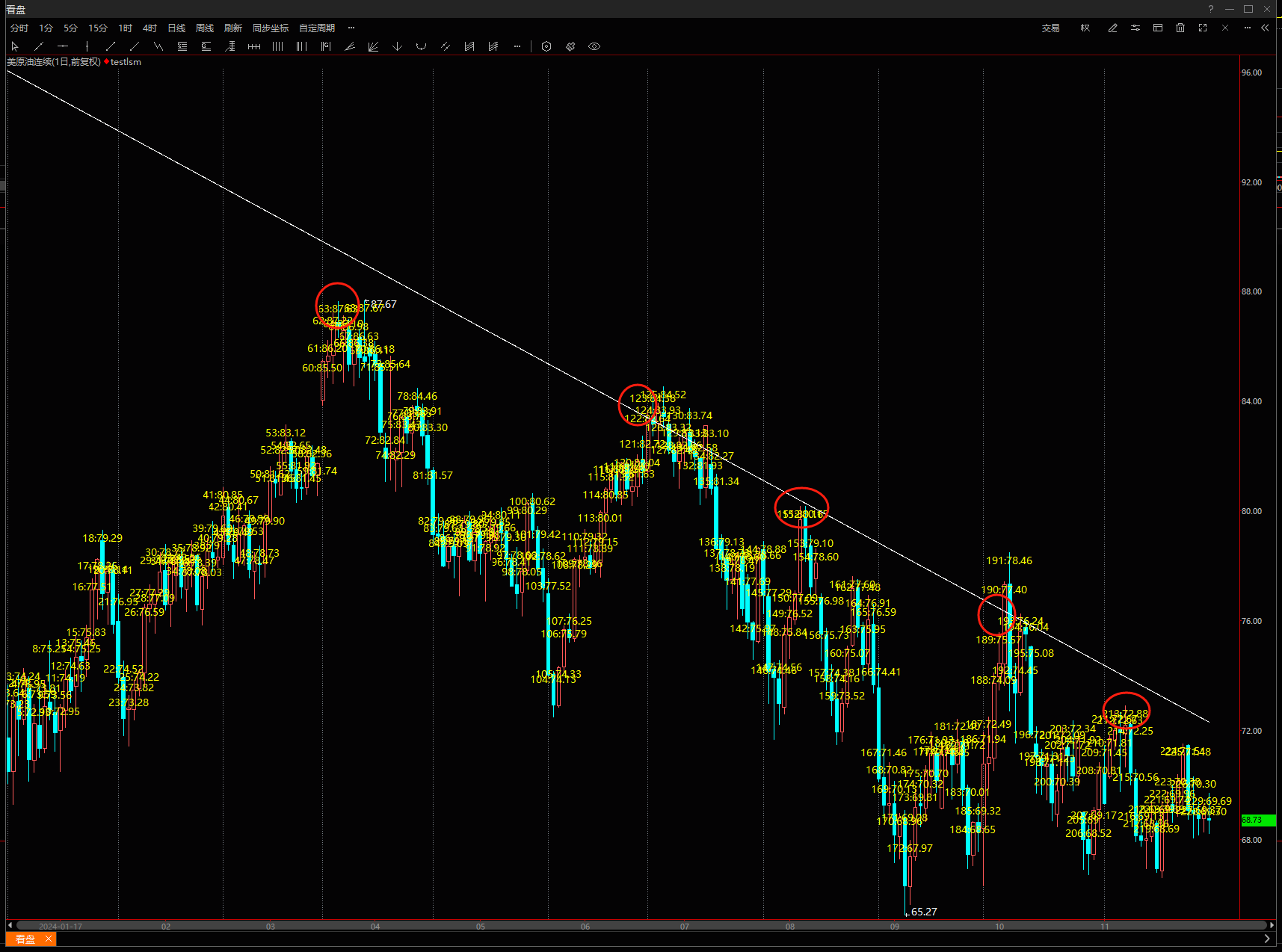谁用TB做过这个工作?请帮忙编程,提供报酬。微信:fzpkkk
n个点,G(P1,C1),G(P2,C2)...G(Pn,Cn),P是这个点距离当前k线的的k线数,P1<P2<...<Pn,C是价格。
求当前k线(P0=0)时的C0的值。
方法:用多元线性回归函数MLRS.先整理方程ax+res =b形式 构造系数矩阵和常数矩阵a b 然后带进去计算就行了
或者用其他方法也可以,只要能解决上面的问题就行。
price_n_a[4] = 87.67;
bar_num_a[4] = 68;
zcl_lsm(bar_num_a,price_n_a,Slope_n,Intercept_n);
}
OnBar(ArrayRef<Integer> indexs)
{
PlotString("CurrentBar",Text(CurrentBar) + ":" + text(h,2),h,Yellow);
Commentary("斜率:" + text(Slope_n,1) + " 截距:" + text(Intercept_n));
zuiyoujie_n_se = Slope_n * CurrentBar + Intercept_n;
PlotNumeric("线性规划",zuiyoujie_n_se,zuiyoujie_n_se,White);
}
老师真厉害
这就是最简单的线性规划 啥时候搞出来 神经网络 机器学习 深度学习的算法 那才牛
Defs
Events
OnInit()
{
SetArraySize(price_n_a, 5, 0);
SetArraySize(bar_num_a, 5, 0);
price_n_a[0] = 78.46;
bar_num_a[0] = 191;
price_n_a[1] = 72.88;
bar_num_a[1] = 213;
price_n_a[2] = 71.51;
bar_num_a[2] = 224;
price_n_a[3] = 84.52;
bar_num_a[3] = 125;
//------------------------------------------------------------------------
// 简称: testlsm
// 名称:
// 类别: 策略应用
// 类型: 用户应用
// 输出: Void
//------------------------------------------------------------------------
Params
//此处添加参数
Vars
//此处添加变量
Series<Numeric> zuiyoujie_n_se;
Array<Numeric> price_n_a;
Array<Numeric> bar_num_a;
Global Numeric Slope_n;
Global Numeric Intercept_n;
 输入图中画圆圈的5个点的数值,得出来的白色的拟合线,还算过关吧
输入图中画圆圈的5个点的数值,得出来的白色的拟合线,还算过关吧
//算出斜率
Slope_n_ref = (arrSize_n * sum_xy_n - sum_x_n * sum_y_n) /temp;
//截距
Intercept_n_ref = (sum_y_n * sum_xx_n - sum_x_n * sum_xy_n) / temp;
Return 1;
End
Begin
arrSize_n = GetArraySize(arr_X);
if(arrSize_n<2)
{
Return 0;
}
sum_x_n = 0;
sum_y_n = 0;
sum_xy_n = 0;
sum_xx_n = 0;
Numeric i ;
for i = 0 to arrSize_n - 1
{
sum_x_n = sum_x_n + arr_X[i];
sum_y_n = sum_y_n + arr_Y[i];
sum_xx_n = sum_xx_n + arr_X[i] * arr_X[i];
sum_xy_n = sum_xy_n + arr_X[i] * arr_Y[i];
}
temp = arrSize_n * sum_xx_n - sum_x_n * sum_x_n;
免费
Params
Arrayref<Numeric> arr_X; //数值型数组
Arrayref<Numeric> arr_Y; //数值型数组
NumericRef Slope_n_ref;//斜率
NumericRef Intercept_n_ref;//截距
Vars
Numeric arrSize_n;
Numeric sum_x_n(0);
Numeric sum_y_n(0);
Numeric sum_xx_n(0);
Numeric sum_xy_n(0);
int main() {
DataPoint dataPoints[] = {{1, 1}, {2, 2}, {3, 5}, {4, 4}, {5, 3}};
int numPoints = sizeof(dataPoints) / sizeof(dataPoints[0]);
double slope = calculateSlope(dataPoints, numPoints);
double intercept = calculateIntercept(dataPoints, numPoints, slope);
printf("最佳拟合直线方程:y = %.2f * x + %.2f\n", slope, intercept);
return 0;
}
double calculateIntercept(DataPoint *points, int count, double slope) {
double sumY = 0, sumXY = 0;
for (int i = 0; i < count; i++) {
sumY += points[i].y;
sumXY += points[i].x * points[i].y;
}
double intercept = (sumY - slope * sumX) / count;
return intercept;
}
double calculateSlope(DataPoint *points, int count) {
double sumX = 0, sumY = 0, sumXY = 0, sumXX = 0;
for (int i = 0; i < count; i++) {
sumX += points[i].x;
sumY += points[i].y;
sumXY += points[i].x * points[i].y;
sumXX += points[i].x * points[i].x;
}
double slope = (count * sumXY - sumX * sumY) / (count * sumXX - sumX * sumX);
return slope;
}